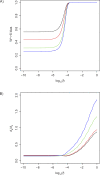Hotspots of biased nucleotide substitutions in human genes
- PMID: 19175294
- PMCID: PMC2631073
- DOI: 10.1371/journal.pbio.1000026
Hotspots of biased nucleotide substitutions in human genes
Abstract
Genes that have experienced accelerated evolutionary rates on the human lineage during recent evolution are candidates for involvement in human-specific adaptations. To determine the forces that cause increased evolutionary rates in certain genes, we analyzed alignments of 10,238 human genes to their orthologues in chimpanzee and macaque. Using a likelihood ratio test, we identified protein-coding sequences with an accelerated rate of base substitutions along the human lineage. Exons evolving at a fast rate in humans have a significant tendency to contain clusters of AT-to-GC (weak-to-strong) biased substitutions. This pattern is also observed in noncoding sequence flanking rapidly evolving exons. Accelerated exons occur in regions with elevated male recombination rates and exhibit an excess of nonsynonymous substitutions relative to the genomic average. We next analyzed genes with significantly elevated ratios of nonsynonymous to synonymous rates of base substitution (dN/dS) along the human lineage, and those with an excess of amino acid replacement substitutions relative to human polymorphism. These genes also show evidence of clusters of weak-to-strong biased substitutions. These findings indicate that a recombination-associated process, such as biased gene conversion (BGC), is driving fixation of GC alleles in the human genome. This process can lead to accelerated evolution in coding sequences and excess amino acid replacement substitutions, thereby generating significant results for tests of positive selection.
Conflict of interest statement
Competing interests. The authors have declared that no competing interests exist.
Figures






References
-
- Pollard KS, Salama SR, King B, Kern AD, Dreszer T, et al. Forces shaping the fastest evolving regions in the human genome. PLoS Genet. 2006;2:e168. doi: 10.1371/journal.pgen.0020168. - DOI - PMC - PubMed
-
- Pollard KS, Salama SR, Lambert N, Lambot MA, Coppens S, et al. An RNA gene expressed during cortical development evolved rapidly in humans. Nature. 2006;443:167–172. - PubMed
-
- Prabhakar S, Noonan JP, Paabo S, Rubin EM. Accelerated evolution of conserved noncoding sequences in humans. Science. 2006;314:786. - PubMed
-
- Galtier N, Duret L. Adaptation or biased gene conversion? Extending the null hypothesis of molecular evolution. Trends Genet. 2007;23:273–277. - PubMed
Publication types
MeSH terms
Grants and funding
LinkOut - more resources
Full Text Sources
Other Literature Sources
Miscellaneous

